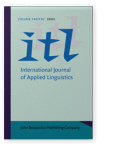Vol. 149/150 (2005) ► pp.47–76
Vol. 149/150 (2005) ► pp.47–76
Investigating the clause complex
An analysis of exposition-type essays written by Secondary School Students in Singapore
The situation in many composition classes in Singapore is characterized by scaffolding (Vygot-sky, 1962; Bruner, 1985), where students are given explicit guidance, particularly concerning the organizational structure of the essay. With scaffolding, there is a concern that the students will produce similarly-structured essays. How then does one differentiate a good essay from a less well-written one? Using Halliday's clause-complex framework (Halliday and Matthiessen, 2004), our analysis shows that while the better writers display a greater mastery of clause-complex structures, the weaker writers rely heavily on simplex constructions. In addition to scaffolding, we argue that the appropriate use of clause-complex structures should be incorporated as part of the writing lesson.
